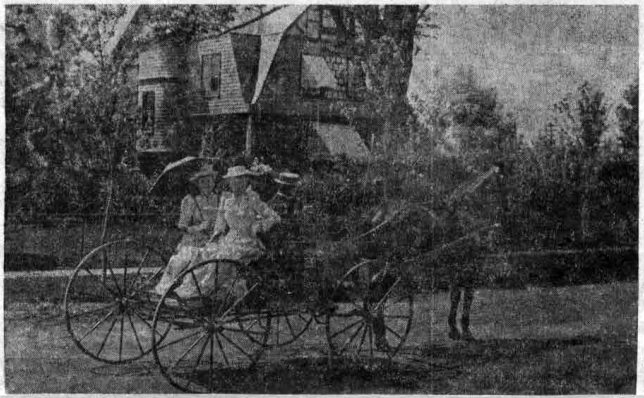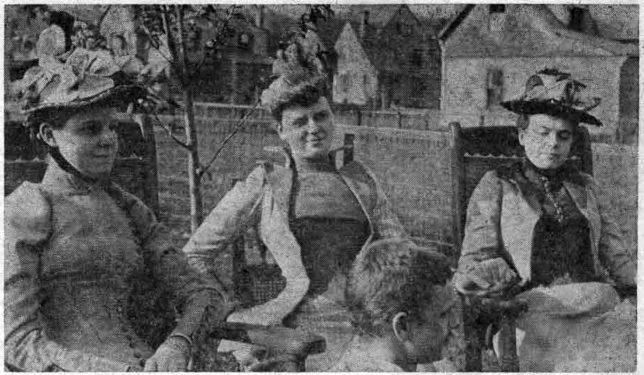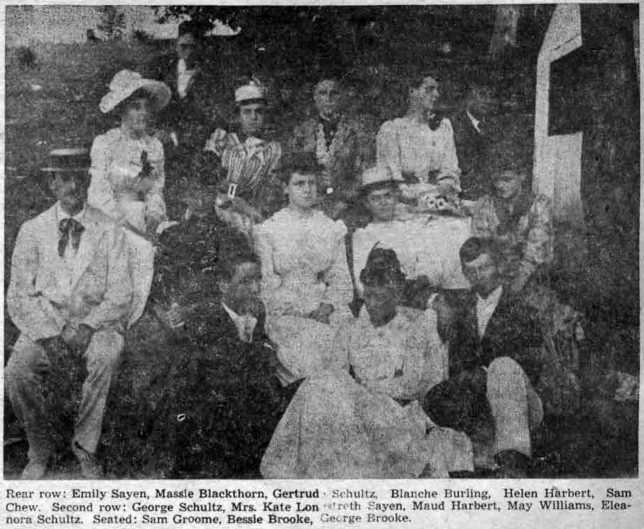In looking over the album of old pictures with Mr. George W. Schultz and his sister, Mrs. Louis D. Peterson, so carefully preserved by the former that they are still clear for reproduction in this column more than 60 years later, it has been interesting to try to discover why their parents should have left the city of Philadelphia in 1888 to establish a new home in what must have seemed at that time a quiet rural section of Pennsylvania. To discover their reasons is perhaps to understand better why George W. Childs should have found it so easy to obtain purchasers for his “Wayne Estate” houses once they were built. The sudden transition from a quiet community of a few farms centering around the Wayne Presbyterian Chapel, the old Opera House and Louella Mansion of Wayne of 1870, to the rapidly growing suburb of 1890 seems, in retrospect, to have been an almost startling one.
George H. Schultz, the father of George W. Schultz and of Mrs. Peterson, was a native Philadelphian, the son of William Schultz, one of the pioneer railroad men in the United States. Always interested in machinery, the latter early became associated with the old firm of Isaac and Levi Morris, rivals at that time of the Baldwin Locomotive Works. He was sent to Berlin with two locomotives, ordered by the Emperor, who had a little railroad which ran the 16 miles between Berlin and Potsdam.
After Mr. Schultz had been in St. Petersburg for a year he sent for his family to join him, and after weeks on a sailing vessel they reached St. Petersburg, their home for the next twelve years. During that period the development of railroading in Russia gained steady momentum. At one time the government offered Mr. Schultz general charge of the entire railroad system of the empire. This, however, he declined, and in 1852 returned to America.
Thus George H. Schultz spent his early boyhood in Russia and received his education there. After his return to America he married, and, with his wife and his young family, lived opposite Franklin Square in a house then located at 244 West Franklin Square, Mr. George W. Schultz, of Wayne, reminisces of that old Philadelphia neighborhood of his youth as “very nice at that time… Franklin Square itself had a fountain in the middle of it and was enclosed by a high iron fence, the gates of which were locked at 10 o’clock in the evening.”
However, as time went on the neighborhood became less and less desirable, and the younger members of the Schultz family felt keenly “the urge to move from the crowded, noisy, smelly city, since almost all who chose suburban life enjoyed better rest, pure air, and the peace and quiet of a full night’s sleep,” again to quote Mr. George W. Schultz. In the meantime Anthony P. Thompson, a former classmate of his at Friends Central School, with whom he had become associated in business, had moved to Wayne and with his mother, his wife and his brother had bought the house and large lot on North Wayne avenue directly opposite Walnut avenue. Mr. Schultz gives a very vivid description of this school friend of his when he says,” He was very English in manner and in dress. He built a stable and kept three horses and a vehicle and became a member of the Radnor Hunt and engaged in the fox chases.”
George Schultz, who had been a frequent visitor at his friend’s house, continues with his story of how he persuaded his own family to move from Philadelphia. “I told my parents what I had seen of Wayne Village and of the new type of houses, and that I wished our family could move out there. I had no idea they would fall for it, but when my parents, my sister and I went out on a train one Sunday, we urged father to buy a Tower House for ample room. I was astonished that they were willing to move out of the city, where we had always lived, and then to commute by train to business daily.”
The year 1888, when they moved, is remembered, Mr. Schultz reminisces, “for the great blizzard. It began March 11, and after three days of snow following a north-east storm, practically all horse cars, wagons and foot travel were stalled for a week, and it was difficult to get to business on foot. I had gone down Gray’s Ferry road by horse-car when the rain changed to hail and snow. Leaving the car, I went to a factory to look at some old boilers for sale. On coming out in the howling gale, I saw a large bundle of clothes rolling across the road and found it was an old woman. I picked her up and helped her to her home close by. The horses had been taken off the street cars in exhausted condition, and I was forced to walk three miles to my home.”
Once in Wayne, it was to one of the new “Tower Houses” of the Wayne Estate to which the Schultz family came, as had been requested by the younger members of the family. (This was incorrectly called a “Round End House” earlier in this series.)
In one of the first brochures sent out by Wendell and Smith of the Wayne Estate, these “Tower Houses,” of which there are a number in North Wayne, are described as having “a very picturesque exterior… large, well shaded portico in the front… A very attractive 13-room house with carved oak staircase. Hard wood finish on the first floor and home-like corners for your furniture. Tasteful effects in stained glass roundels. The very best of everything is in this house.”
This home of the Schultz family is the one now numbered 211 Walnut avenue. The one to the right of it was occupied by Mr. and Mrs. Henry Baring Powel. Later Mr. and Mrs. Robert Hare Powel also came to South Wayne to live. The Powel brothers were young men of about the same age as George Schultz and his brothers, and close friends of theirs. They had formerly lived in Philadelphia, just as the Schultz family had, moving to Wayne for much the same reasons as the latter had done. The Powel house on South 3rd street, Philadelphia, which dated back to 1768, was of such beauty and such historical interest that the furnishings of its drawing room have been moved into a similar room in the Philadelphia Museum of Art, where it is the center of great interest to visitors.
Thus we glimpse why at least three Philadelphia families, first the Thompsons, then the Schultzes and soon thereafter the Powels, moved from well established Philadelphia homes to what had been the quiet little rural settlement of Cleavers Landing, later named Wayne, to be among the first owners of George W. Childs’ Wayne Estate houses.







